12.3 Graphical Representation of Complex Numbers
Complex Plane • Complex Number as a Point • Adding and Subtracting Complex Numbers Graphically
Graphically, we represent a complex number as a point, designated as in the rectangular coordinate system. The real part is the x-value of the point, and the imaginary part is the y-value of the point. Used in this way, the coordinate system is called the complex plane, the horizontal axis is the real axis, and the vertical axis is the imaginary axis.
EXAMPLE 1 Complex numbers in the complex plane
In Fig. 12.3, A represents the complex number B represents and C represents These complex numbers are represented by the points and respectively, of the standard rectangular coordinate system.
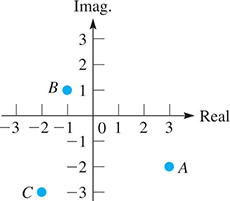
Fig. 12.3
Keep in mind that the meaning given to the points representing complex numbers in the complex plane is different from the meaning given to the points in the standard rectangular coordinate system. A point in the complex plane represents a single complex number, whereas a point in the rectangular coordinate system represents a pair of real numbers.
In the complex plane, consider two complex numbers—for example, and —and their sum Drawing lines from the origin to these points (see Fig. 12.4), note that if we think of the complex numbers as being vectors, their sum is the vector sum. Because complex numbers can be used to represent vectors, the numbers are particularly important. Any complex number can be thought of as representing a vector from the origin to its point in the complex plane. This leads to the method used to add complex numbers graphically.
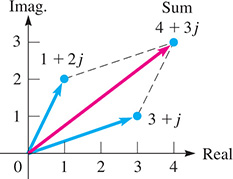
Fig. 12.4
NOTE
[Note that this is equivalent to adding vectors by graphical means.]
EXAMPLE 2 Adding complex numbers graphically
Add the complex numbers and graphically.
The solution is shown in Fig. 12.5. We see that the fourth vertex of the parallelogram is at This is, of course, the algebraic sum of these two complex numbers.
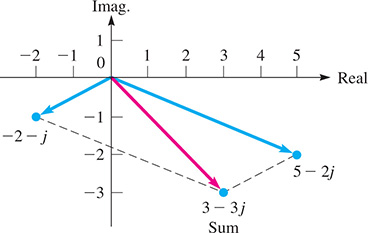
Fig. 12.5
Add the complex numbers and
First, note that which means that the point representing is on the negative real axis. In Fig. 12.6, we show the numbers and on the graph and complete the parallelogram. From the graph, we see that the sum is
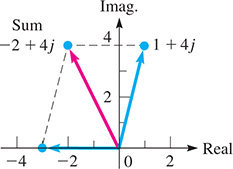
Fig. 12.6
EXAMPLE 3 Subtracting complex numbers graphically
Subtract from graphically.
Subtracting is equivalent to adding Therefore, we complete the solution by adding and as shown in Fig. 12.7. The result is

Fig. 12.7
EXAMPLE 4 Adding complex numbers—forces on a bolt
Two forces acting on an overhead bolt can be represented by and Find the resultant force graphically.
The forces are shown in Fig. 12.8. From the graph, we can see that the sum of the forces, which is the resultant force, is
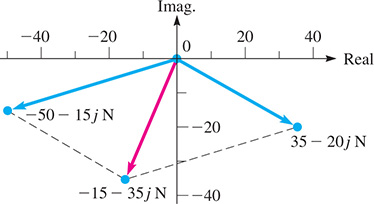
Fig. 12.8
Exercises 12.3
In Exercises 1 and 2, perform the indicated operations for the resulting complex numbers if the given changes are made in the indicated examples of this section.
In Example 2(a), change the sign of the imaginary part of the second complex number and then add the numbers graphically.
In Example 3, change the sign of the imaginary part of the second complex number and do the subtraction graphically.
In Exercises 3–8, locate the given numbers in the complex plane.
10
In Exercises 9–26, perform the indicated operations graphically. Check them algebraically.
In Exercises 27–30, show the given number, its negative, and its conjugate on the same coordinate system.
In Exercises 31 and 32, show the numbers and on the same coordinate system. The multiplication of a complex number by a real number is called scalar multiplication of the complex number.
![]() In Exercises 33–36, perform the indicated vector operations graphically on the complex number
In Exercises 33–36, perform the indicated vector operations graphically on the complex number
Graph the complex number and its conjugate. Describe the relative positions.
Add the number and its conjugate. Describe the result.
Subtract the conjugate from the number. Describe the result.
Graph the number, the number multiplied by j, the number multiplied by and the number multiplied by on the same graph. Describe the result of multiplying a complex number by j.
In Exercises 37 and 38, perform the indicated vector additions graphically. Check them algebraically.
Two ropes hold a boat at a dock. The tensions in the ropes can be represented by and Find the resultant force.
Relative to the air, a plane heads north of west with a velocity that can be represented by The wind is blowing from south of west with a velocity that can be represented by Find the resultant velocity of the plane.
